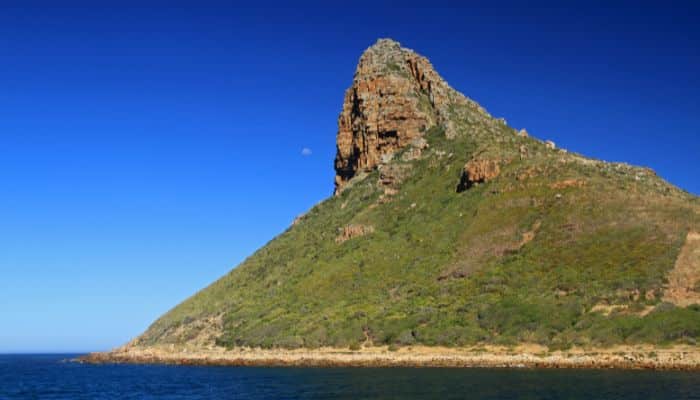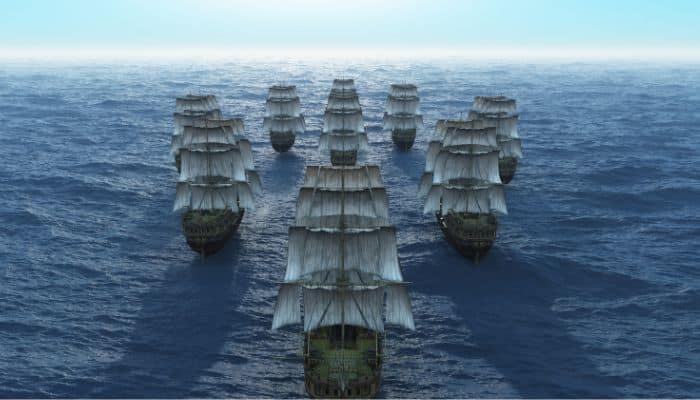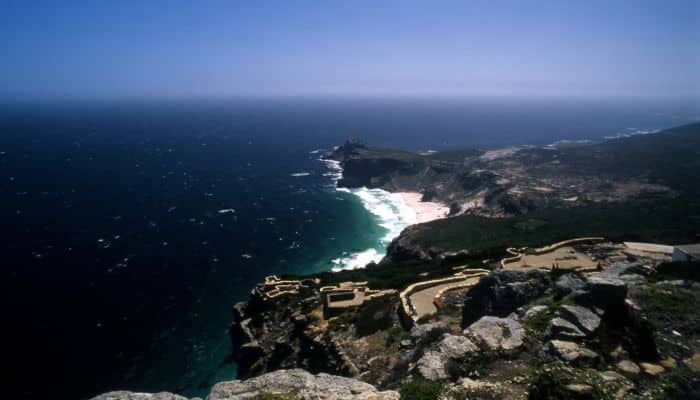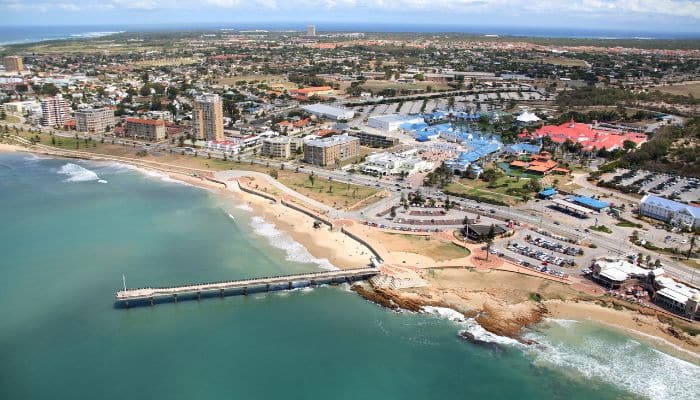8 Interesting Facts About Cape Route
Cape Route, also referred to as the European Asian Sea Route, the sea route to India or simply the Cape Route, is an important waterway stretching from the European shores of the Atlantic Ocean to the Asian coast of the Indian Ocean.
Read along to discover more about the Cape Route and its historical significance.
1. Cape Route goes all the way from the Cape of Good Hope and Cape Agulhas
Ships on the Cape Route usually left Europe from southwest Portugal, southwest Spain or Gibraltar. The next stop could be the Canary Islands and other islands off the coast of Africa, like Madeira and Cape Verde.
Other places on the route were Dakar, Senegal and Tristan da Cunha, an island between Cape Town and Buenos Aires, home to the world’s most remote human settlement. The next major stops were Saint Helena Islands and Salvador in Brazil, Lüderitz, Namibia and Cape Town in South Africa.

Cargo ships also stopped at Zanzibar, Tanzania, which was a key port for the Arab trading communities and later for Europeans too. Another significant stop was Mombasa in Kenya, and after leaving Mombasa, ships could also arrive at Malindi, also in Kenya.
Interestingly, explorer Vasco de Gama reached Malindi. A pillar still stands at the place where he came to the shore. Soon, Malindi gained a pivotal position with the development of the Indian Ocean trade network.
The fleet of Admiral Zheng, who was a Chinese mariner and diplomat in the Ming Dynasty, also visited this important trading town. Malindi reached its zenith during the spread of Portuguese influence but declined with the growth of European colonisation in the region.
The next stop of the route was usually Kozhikode or Calicut in India, a vital port lying on the Maritime Silk Road and Goa, where the Portuguese founded their first-ever Asian colony, and now the smallest state of India in terms of area covered.
2. Portuguese Explorer Vasco da Gama Found the Cape Route in 1498
The Cape Route was discovered in 1498 by Vasco da Gama, who headed the expedition to find a sea route to India during the reign of King Manuel I in 1495–1499. The aim was to find a trade route with Asia and to monopolise the spice trade.
The voyage began on July 8, 1497, with a 170-member crew, including two interpreters. The sailors had prepared charts with locations on the African coast, tables with calculations, quadrants, astrolabes, etc., to guide them correctly.
There were 3 ships and another which carried groceries for 3 years, including beans, dried meat, olive oil, pickles, medicine, wine and biscuits. They had decided to stop along the African coast to replenish their stock of food. The three ships had a captain and a pilot, while the ship carrying groceries had a captain only.
Those onboard recorded their experiences, such as sighting rich flora and fauna along the coast of Africa. They also came in contact with tribes close to the St. Helena Bay. These tribes were described as peculiar since they ate sea lions and roots of herbal plants, covered themselves with the fur of animals, made wooden weapons, and played rustic flutes, something the Portuguese saw for the first time.
They crossed the bay and then reached Mozambique. This perilous voyage was fraught with many challenges. The sailors raided ships and acquired prisoners who could be sold or put to work.
Finally, on May 17, 1498, the expedition reached Kappakadavu, near Calicut, Kerala, thus finding a route to India via the Indian Ocean.
3. The Cape Route was important during the Age of Sail
Age of Sail was a period that lasted from the 16th to the mid-19th centuries, marked by the growing dominance of sailing ships in the realm of global trade and naval warfare using artillery.
During this time, the spice trade from India and the Silk Road from China were very important. However, after the fall of Constantinople in 1453 disrupted trade and made finding a sea route necessary. Several Portuguese explorers like Diogo Cao and Bartolomeu Dias explored the African coast, with the latter finding the Cape Of Good Hope in 1488.

Since Vasco da Gama headed an expedition to India, the Cape Route began to be used extensively. Christopher Columbus also tried to find a westward route to India but reached the Americas.
These expeditions by explorers marked the advent of the Age of Discovery, in which these curious travellers crossed the world’s oceans, discovering new territories, ultimately paving the way for European colonisation in these regions.
The Cape Route began to be used by the European East India Companies in the 17th century. The colonisation of Africa before the end of the 19th century was mainly limited to some coastal outposts for supporting the Cape Route.
Here, the Dutch East India Company established their Cape Colony as a stopover port on the way to the Dutch East Indies.
4. An extension of the Cape Route was the Brouwer Route, going from the Indian Ocean to Indonesia
This route was used by ships headed to the Dutch East Indies from the Cape of Good Hope. It took vessels south from the Cape to the Roaring Forties, then to the Indian Ocean, before turning northwest for Java, Indonesia.
This route, found by Dutch navigator Hendrik Brouwer in 1611, after whom it is named, decreased the time of travel between the Cape of Good Hope to Java from 12 to 6 months compared to the monsoon route of Arabs and Portuguese.
However, this route was quite dangerous as there was no precise method to know the longitude and thereby for captains to understand how far east the ship had gone. Seeing Amsterdam Island or Saint Paul Island was the only way for vessels to change their direction; however, this depended on the captain’s foresight and experience.
Hence, many ships which crossed this route ended up being grounded on rocks, reefs and islands.
This route went from the coast of East Africa in a northward direction, all the way through the Mozambique channel and then across the Indian Ocean. By 1616, the Dutch East India Company made it mandatory for its ship captains to know the Brouwer Route.
Captain Humphrey Fitzherbert from the British East India Company was the first to try this route in 1620, which they called the Southern route.
He was successful; however, the second English vessel that tried to pass through sailed too far east and was wrecked off Australia’s Pilbara coast in 1622, which led to the English avoiding this route for at least the coming 20 years. This route was central to the discovery of the western coast of Australia by the Europeans.
5. The Portuguese Empire was centred around the Cape Route
Portuguese Empire reached its highest point during the Age of Exploration and was centred around the Cape Route, also called the Cape of Good Hope Route. This route was pivotal for expanding their influence in the 15th and 16th centuries.
Vasco da Gama’s successful voyage to India paved the way for the expansion of the Portuguese Empire, which established many trading posts and ports, such as Goa in India and Malacca in Southeast Asia.

They controlled the Cape Route and dominated the spice trade by monopolising cinnamon, cloves, and pepper, which were highly in demand in Europe.
This gave them an economic advantage, and they established colonies in other parts of Africa like Mozambique and Angola, in Brazil and several islands in the Indian and Atlantic Oceans.
However, they began to face competition from other European powers like the Dutch and English as they, too, went to establish their colonies and trading posts in the region. Slowly, the Portuguese influence waned.
6. Cape Route lost its importance after the opening of the Suez Canal
The Suez Canal opened in 1869, providing a short route between the Atlantic and the Indian Ocean. Due to the prevailing winds here, the canal was not much suited for sailing boats and hence, steamships got an advantage in the early years of its opening.
Its opening marked the end of the Cape Route along with the Age of Sail. Today, almost all ships pass through the Suez Canal, and the Cape Route has become a famous place for yacht racing.
However, the Cape Route is an alternative route in case the traffic in the canal is disrupted due to any reason or for ships that do not want to pay fees for crossing the Suez Canal. If the ships travel via the Cape Route instead of the Suez Canal, the journey becomes two weeks longer.
7. Several trading ports lie along the Cape Route
The historically significant Cape Route that ships used for navigating around the Cape of Good Hope to reach the Indian Ocean and beyond is dotted with many ports.
One such is the Port of Cape Town, lying on the western side of Cape of Good Hope. It was once a major stop for vessels going along the Cape Route. Today, it is a busy commercial port with 4 basins and 34 berths. It is a key container port dealing with the largest amounts of fresh fruits and is home to fishing fleets and repair facilities. The main cargo handled here includes wine, meat, machines, clothes and tiles.

Located in Algoa Bay, on the eastern Cape Province along South Africa’s southern coast, Port Elizabeth is the fifth biggest port in South Africa based on cargo handled. It has a 1.6 nm entrance channel and a 1200 m breakwater. The port’s specialised terminals efficiently handle agricultural goods, general cargo, timber, textiles, skin, hides, containers and citrus fruit.
Durban Port on South Africa’s east coast is the busiest port in the country, equipped with a modern harbour having 59 berths and an SBM for VLCCs. It deals with wheat, containers, coal, granite, soda ash and other miscellaneous goods.
There were many other ports along the Cape Route as well, such as Maputo in Mozambique, Mossel Bay, Zanzibar, Goa, Cochin, Singapore, etc.
8. Home to many shipwrecks due to unpredictable weather and strong currents
The Cape Route was a perilous one, given the harsh weather conditions, its strong winds and currents, making it challenging to navigate. Hence, several ships that tried to pass through it met their demise over centuries.
The Cape of Good Hope is also called the Graveyard of Ships since this coastline is dotted with around 3000 shipwrecks.
One such ship was HMS Birkenhead, which was wrecked on Birkenhead Rock off Danger Point. It was going from Britain to South Africa, loaded with reinforcements for the 8th Frontier War in the Eastern Cape.
It is famous for its ‘women and children first’ protocol; however, despite attempts, around 300 people lost their lives.
Thermopylae was a steam-powered freighter that was wrecked at Greenpoint Lighthouse in Table Bay, in the Western Cape, on the Thermopylae reef. It met a tragic fate on the moonlit night of 11th September 1899 only because of an error in judgement.
You might also like to read-
- Top 10 Fjords in Norway
- 7 Major Ports Of Croatia
- 10 Biggest Straits Of The World
- 10 Largest Estuaries In The World
- 15 Biggest Wooden Ships Ever Built
Disclaimer :
The information contained in this website is for general information purposes only. While we endeavour to keep the information up to date and correct, we make no representations or warranties of any kind, express or implied, about the completeness, accuracy, reliability, suitability or availability with respect to the website or the information, products, services, or related graphics contained on the website for any purpose. Any reliance you place on such information is therefore strictly at your own risk.
In no event will we be liable for any loss or damage including without limitation, indirect or consequential loss or damage, or any loss or damage whatsoever arising from loss of data or profits arising out of, or in connection with, the use of this website.
Do you have info to share with us ? Suggest a correction
Disclaimer :
The information contained in this website is for general information purposes only. While we endeavour to keep the information up to date and correct, we make no representations or warranties of any kind, express or implied, about the completeness, accuracy, reliability, suitability or availability with respect to the website or the information, products, services, or related graphics contained on the website for any purpose. Any reliance you place on such information is therefore strictly at your own risk.
In no event will we be liable for any loss or damage including without limitation, indirect or consequential loss or damage, or any loss or damage whatsoever arising from loss of data or profits arising out of, or in connection with, the use of this website.

About Author
Zahra is an alumna of Miranda House, University of Delhi. She is an avid writer, possessing immaculate research and editing skills. Author of several academic papers, she has also worked as a freelance writer, producing many technical, creative and marketing pieces. A true aesthete at heart, she loves books a little more than anything else.
Latest Maritime Knowledge Articles You Would Like:
Subscribe To Our Newsletters
By subscribing, you agree to our Privacy Policy and may receive occasional deal communications; you can unsubscribe anytime.















